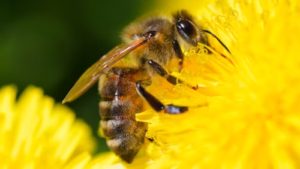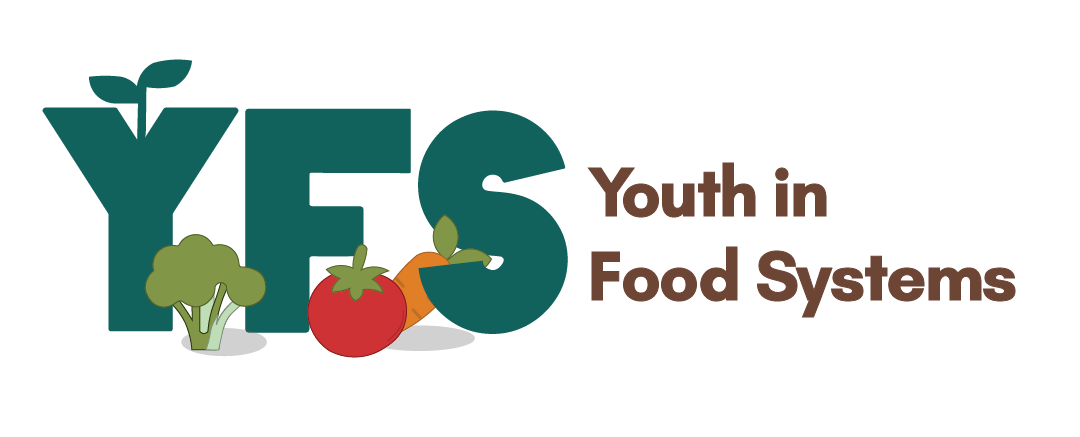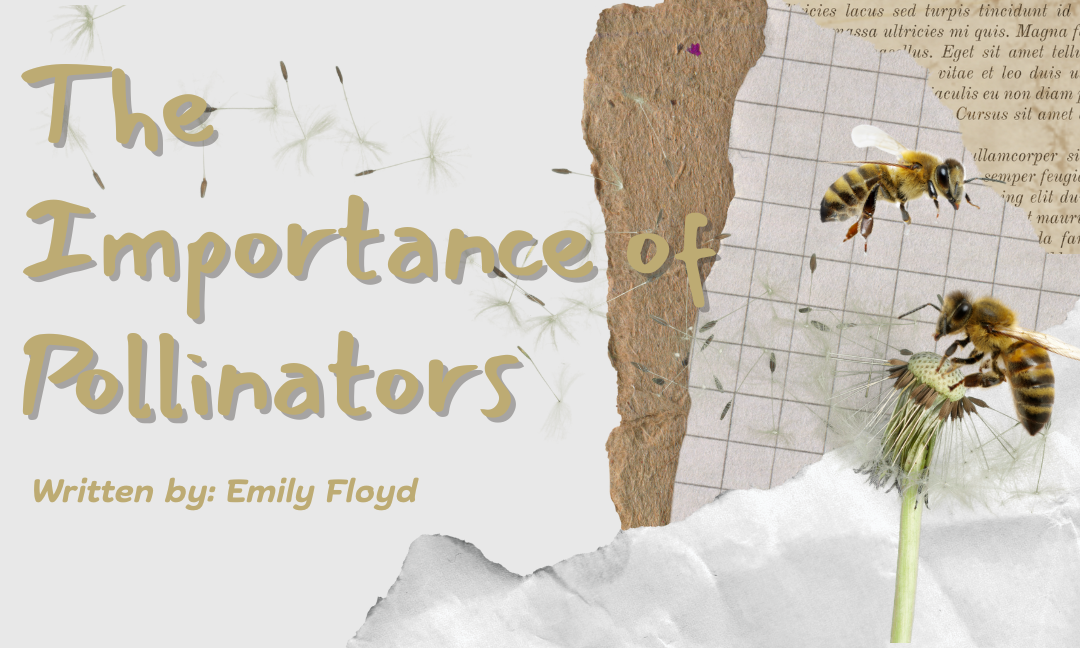Written by: Emily Floyd
Edited by: Alessa Zaitseva
Designed by: Andria Sahar
Published by: Andrew Jackson
With spring on its way, many Canadians think of warmer weather and flowers. But besides spring, what do these things have in common? Pollination. You may not think of it often, but pollination plays a huge part in our day to day lives. Nearly ⅓ bites of food you eat depend on pollinators, and about 75% of plants and flowers need pollination to grow seeds and produce food. That’s about 35% of the crops people harvest and consume around the world. But what is pollination, and how does it work?
Pollination consists of three things: a pollinator, a flowering plant, and pollen. Pollen is a fine substance that typically appears yellow. It is found in the male part of a flower called an anther, and helps plants reproduce and grow food. In order to pollinate another flower, a pollinator comes along, such as a bee or hummingbird, and lands on a flower. Pollen sticks to the animal’s or insect’s body or legs. When the pollinator then lands on a different plant, all of that pollen rubs off onto the flower’s stigma, which is the female flower’s reproductive system, responsible for creating new seeds. The pollen then travels to the plant’s ovary, where the eggs are fertilized and new seeds are eventually produced.
There are many types of pollinators, including butterflies, bees, beetles, hummingbirds, ants, moths, some species of flies, and even the wind. These things are responsible for pollinating many different types of crops, including but not limited to apples, alfalfa, vanilla, coffee, strawberries, cacao, raspberries and other types of fruit, berries, and nuts. But it isn’t just humans that benefit from pollination. Many cows that produce our dairy eat alfalfa, and many species of birds eat the pollinators themselves. So while they’re feeding us, they’re also feeding the environment.

But the cold winter months spark a question: where do they live? We rarely see pollinators during winter because they hibernate. But where? Some insects like ants and bees have ready-made nests, but many others live in small spaces made in human-made structures, piles of sticks, in hollow tree bark, or decide to migrate. Pollinators tend to pick spaces with access to clean, shallow water and pollen sources nearby. But with construction and deforestation, it’s making it harder for them to find suitable homes. Humans are quickly tearing down trees and building on fields, which limits pollinator’s access to pollen and a home. In spite of this, there are things you can do to help.
Firstly, you can start by planting a garden with pollinator-friendly and native plants. These include: catmint, coneflower, goldenrod, false indigo, lavender, milkweed, sunflower, and more. The more diverse your garden is, the more helpful it is to pollinators. If you don’t have a garden or space to start one, you can use a flower box or join a local community garden. Secondly, try to buy organic and locally grown food. Many farmers use pesticides, which is a chemical that kills off insects from our food, but it can also kill pollinators. By buying organically, you aren’t supporting the use of pesticides, which will benefit pollinators greatly. Lastly, you can spread the word about pollinators. You don’t have to do something extravagant or large to help. By telling your friends and family, or even making a social media post, you’re bringing up the importance of saving our pollinators and all that they do for us and our planet. Despite their small size, the impact pollinators have is huge.
Sources:
- 7 effective ways to protect pollinators and help our ecosystem. (2021, June 10). Alvéole. https://www.alveole.buzz/blog/ways-to-protect-pollinators/
- 30 Essential Pollinator Plants for Your Garden – Garden Design. (2024). GardenDesign.com. https://www.gardendesign.com/plants/pollinators.html
- Mizejewski, D. (2021, June 5). 10 Ways to Save Pollinators – The National Wildlife Federation Blog. The National Wildlife Federation Blog. https://blog.nwf.org/2021/06/10-ways-to-save-pollinators/
- Quick Facts. (2025). Pollinationguelph. https://www.pollinationguelph.ca/quickfacts
- The Why, What, When, Where, Who, How of Pollination – Smithsonian Gardens. (2021, October 25). Smithsonian Gardens. https://gardens.si.edu/gardens/pollinator-garden/why-what-when-where-who-how-pollination/
- What is Pollination? | US Forest Service. (2022). US Forest Service. https://www.fs.usda.gov/managing-land/wildflowers/pollinators/what-is-pollination#:~:text=Pollination%20is%20the%20act%20of,offspring%20is%20by%20making%20seeds.
- Where do pollinators go in winter? | Wild Pollinator Partners. (2025). Wildpollinators-Pollinisateurssauvages.ca. https://wildpollinators-pollinisateurssauvages.ca/2018/03/18/where-do-pollinators-go-in-winter/
- Image by KP Bandyopadhyay on unsplash.com

